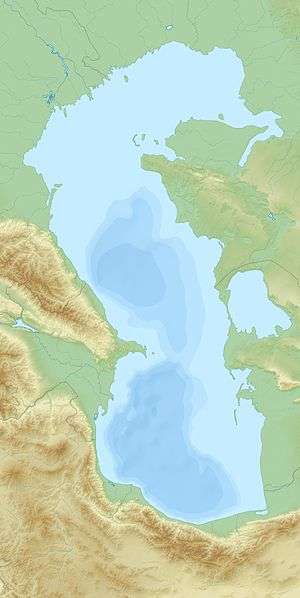Miankaleh peninsula
Miyānkāle peninsula (Persian: شبه جزیره میانکاله) is a long, narrow peninsula in Behshahr County of Māzandarān Province in the north of Iran situated in the extreme south-eastern part of the Caspian Sea. The elongate peninsula is 48 kilometres (30 miles) long, and between 1.3 and 3.2 kilometres (1,400 and 3,500 yards) wide.
Miankaleh peninsula شبه جزیره میانکاله Miyānkāle peninsula | |
|---|---|
 | |
 Miankaleh peninsula | |
| Coordinates: 36.8833°N 53.75°E | |
| Country | Iran |
| Province | Māzandarān Province |
| Sea | Caspian Sea |
| Website | http://miankaleh.com |
| Designations | |
|---|---|
| Official name | Miankaleh Peninsula, Gorgan Bay and Lapoo-Zaghmarz Ab-bandan |
| Designated | 23 June 1975 |
| Reference no. | 36[1] |
It sets apart the Gorgan Bay from the Caspian Sea. The elevation of the peninsula from the sea level is 23 meters. Four villages are situated on it, namely: Ashuradeh, Qezel-e shomali, Qezel-Mehdi, and Qavasatl. The city situated at the opposite side of the peninsula's end is Bandar Torkaman. The island of Ashuradeh lies off the eastern tip of the peninsula.
Ecology
Miankaleh peninsula is one of the richest ecological havens in West Asia and perhaps in the whole world. It is home to many unique Caspian bird and reptile species native to this region. It is also a very important internationally recognized refuge for migratory birds. Flora and fauna include:
- Plants: Raspberry, common medlar, Mediterranean hackberry, Jerusalem thorn, Populus, Salsola, Cyperaceae, and Polygonum;
- Fish: Common carp, Caspian white fish, zander, crucian carp, mullet;
- Birds: Coot, purple swamphen, smew, flamingo, white-headed duck, red-breasted goose, whooper swan, black francolin, peregrine falcon, and little bustard;
- Mammals: Wolf, jackal, fox, hedgehog, wild boar, Caspian seal.
The peninsula, with Gorgan Bay, has been designated an International Wetland (Ramsar site) in 1975[3] and an international UNESCO Biosphere Reserve in 1976.[4] On the national level, it is protected under the "Wildlife Refuge" status by the Iranian Dept. of Environment.[5]
Siberian Tiger Introduction Project
One of the indigenous predators of Iran, the Caspian tiger, used to live in the north-western to north-eastern parts of the country. In 2010, a pair of Siberian tigers was sent from Russia to Iran's Tehran Zoological Garden in exchange for their Persian leopards. The Siberian tigers currently in captivity are set to be reintroduced in the wild to replace the Caspian tigers on the Miankaleh peninsula.[6] Iran received two more pairs of Siberian tigers in 2012.[7][8]
Threats
This nature reserve is vulnerable to industry and tourism. While tourism-related activities continue to pollute the area, the Iranian government plans to build a huge hotel complex right in the middle of this nature park. Parts of the peninsula have already been sold by the government for industrial and residential purposes.
The number of migratory birds has fallen significantly during the past few years. Extensive fishing and hunting has damaged the ecological balance, and many species are either moribund or under threat of total extinction.
References
- "Miankaleh Peninsula, Gorgan Bay and Lapoo-Zaghmarz Ab-bandan". Ramsar Sites Information Service. Retrieved 25 April 2018.
- "UNESCO Biosphere Reserve Directory".
- Ramsar sites database Archived 2009-09-27 at the Wayback Machine
- UNESCO biosphere reserve directory
- The Iranian Dept. of Environment Website
- "Big Cat Swap Raises Questions". Institute for War and Peace Reporting. 19 May 2010. Retrieved 30 October 2015.
- "Russian tigers to take their stripes to Iran". RT. 28 February 2012. Archived from the original on 28 January 2016. Retrieved 4 January 2016.
- Ewan Palmer (1 March 2012). "Russia Sends Siberian Tigers to Iran to Save Species". International Business Times. Retrieved 23 January 2016.
External links
- Bakhtiyari, Sa'id, Atlas-e gitashenasi-ye Ostanha-ye Iran (Geographical atlas of Iran's provinces), Tehran: 1383 H.sh., p. 168.
- Memar, Parya, „New urban Settlements in the ecological context; Miānqāla and its new settlement in the south eastern coasts of Caspian Sea“. In: Sustainable Development of Emerging Settlement Patterns, Berlin 2006: pp. 88–102 (ISBN 978-3-7983- 2022-2)

